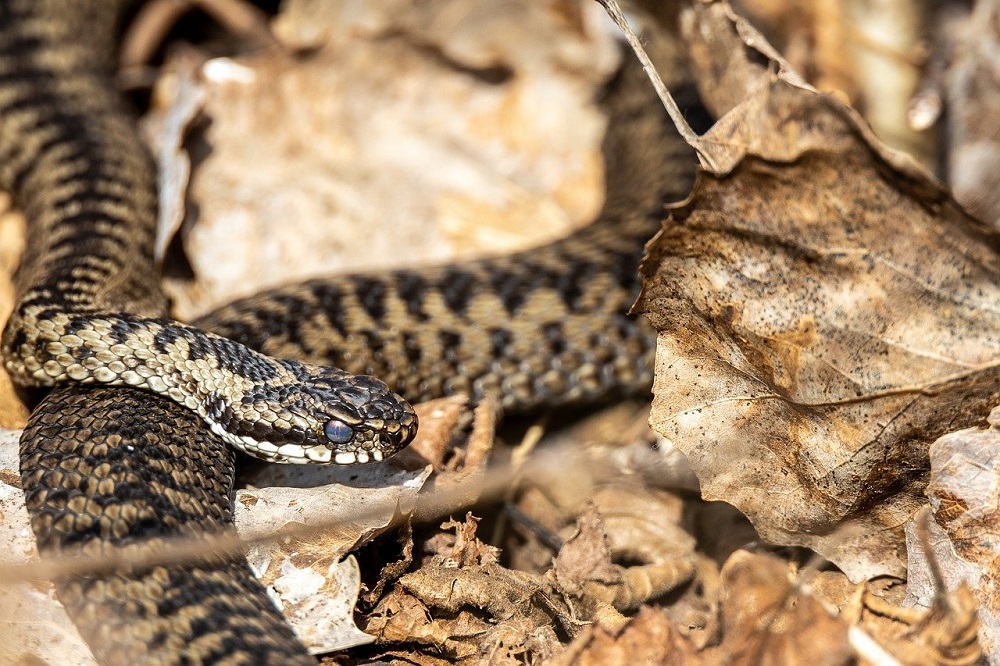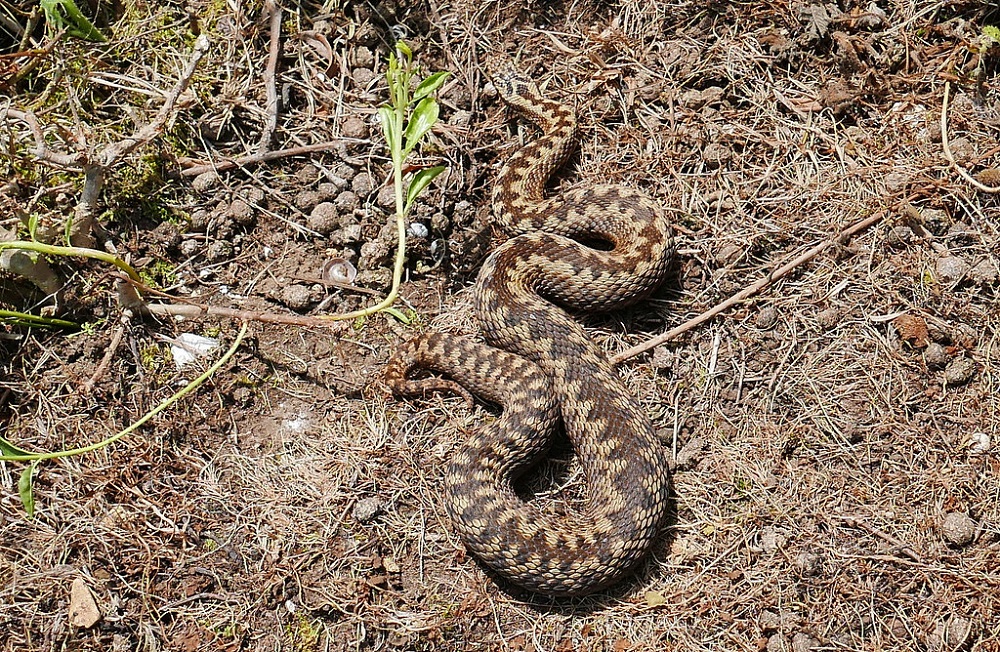In search of Adders: Tawny Clark heads to Parc Slip Nature Reserve on the trail of the UK’s only venomous reptile

Tawny Clark
22nd June 2021. I’ve come to Parc Slip Nature Reserve near Bridgend in South Wales to meet Peter Hill from ARC (Amphibian and Reptile Conservation). As I arrive, Peter’s pointed finger is wiggling before I’ve even stepped from my car.
‘Here’s your first species of the day,’ he calls over, as I make my way to the wooden fence that surrounds the car park. He’s spotted a tiny Common lizard (Zootoca vivipara) basking in the early morning sunshine.
It’s a ‘blink and you’ll miss it’, walk straight past, kind of creature. Camouflaged so precisely against the post, it’s indiscernible from the mottles and flecks of the woodgrain and lichen.
It takes several moments before I experience that elated moment of recognition, like staring at a magic-eye puzzle until the image suddenly appears before you. It’s so obvious you can’t comprehend how you missed it to start with.
Our trip is a last minute, ‘Are you free tomorrow?’ type of outing, to which I immediately respond, ‘Yes,’ before remembering how tired I am. I’ve had bat surveys at ridiculous o’clock this last week and been daydreaming of a full night’s sleep, a lie-in even, but it looks like that’ll have to wait for now. I set two alarms for this early start – just to be sure.
These practical field surveys have been a nostalgic nudge, but also a reminder of just how relentless this line of work can be during active survey season. I’m nearly a decade older than when I did this full time, and with exuberant children usually preventing any chance of a rest, I feel twice that. But now I’m here it feels good to be out in the sunshine. I’m glad I dragged myself out of bed.
The weather looks promising. It’s dry. The sky is crystal blue. I’m quietly optimistic, although Peter reiterates his cautionary words from our previous meeting, ‘It’s not the ideal time of year.’
I do need to remind myself not to get my hopes up and to prepare for disappointment. It’s hard though because I have a really good feeling about this one.
[mid-content banner]
Vipera berus
I’m here because I’m desperate to see Britain’s only venomous reptile for myself. The Common European Viper, Vipera berus. Snakes have long been associated with folktales and legends of biblical proportions; this one goes by many names – but most know it best as the Adder. Despite having spent years in active pursuit of reptiles as a professional ecologist, the adder has thus far eluded me.
We hop over a gate into a damp meadow filled with ragged robin, buttercups, and orchids. It’s being managed to conserve ground-nesting birds like lapwing, skylark and meadow pipit, but it supports other, non-avian populations too. Peter and his team at ARC work in partnership with the Wildlife Trust here – creating and managing habitats to benefit herpetofauna (amphibians and reptiles).
The ecological consultant in me, ‘the lifter’ is excited to see reptile mats sprinkled throughout the fringes of the meadow.
This ‘ground-baiting’ or ‘tinning’, with artificial refugia (refuges) can make reptiles easier to discover. They are often attracted to the shelter and heat generated by squares of up-turned black bitumen roofing tiles, or sheets of corrugated metal – both commonly used by reptile surveyors.
Not that I’m given a chance to lift any, Peter is on a mission. His long legs stride across the rutted ground with practiced ease, whereas I’m more cautious. I’ve rolled ankles on smoother surfaces than this. I’m also a little nervous, considering who lives here.
Most reptile mats are still shaded. They are cold to the touch, and damp with dew underneath. These artificial, garish sunbeds don’t yet appeal to our scaled and slithery friends. A full lap of the large field reveals nothing, not even a slow worm.
I feel the familiar creep of disappointment as this is ideal habitat and if there’s not a single reptile in sight – even under the mats that are in full sun – then this whole trip seems suddenly doomed. We’re in the right place, just not at the optimal time of year. I’m aware that my scepticism has dialled up a few notches as we climb back over the gate onto the path.
Danger
We head into another non-public area and I instantly get a ‘reptile vibe’. I realise this innate sense of high alert was missing in the meadow. Unlike there, here, I’m a wild pony sensing danger, ears pinned forward, smelling the air, eyes wide, scanning, muscles tensed ready for flight.
The habitat is a hurriedly sewn patchwork blanket of woodland, scrub and open heathland. There are brash piles, ditches, scrapes of bare earth, ponds. It reminds me very much of the Surrey heathlands I ran roughshod over in school holidays as a child. I wish I’d paid more attention to the patches of open ground in the heather then. They would likely have been writhing with adders. But my mind was usually occupied with creatures of the larger, legged variety. I would endlessly follow the crescent moon indents of horseshoes in the sand. I longed to be aboard, to feel the rush of speed, the exhilaration of a hell-for-leather gallop.
I’m glad for the slower pace these days. Only now am I beginning to fully appreciate the benefits of calming down and paying closer attention.
Reptile mats litter the ground. Peter turns a few. They’re well-hidden and he knows where they are, so he always gets to them before I do. Which is fine – it’s his job – but I can’t help itching to turn some for myself.
Nothing beats that feeling of flipping a reptile mat and discovering what lurks beneath. Mammal burrows and runs often swirl about in the yellowing grass under a mat. I found a nest of cashew-sized mice pups under one once, and quickly replaced their weather-proof roof. No reptiles under that one, unsurprisingly.
Each fruitless flip is laced with disappointment. It doesn’t get any easier. After innumerable disappointments, I still get that knot of excitement in my stomach just before a mat is turned. Every time.

Peter is a few paces in front of me and casually leans down to lift what must be about his fortieth mat of the morning. He doesn’t appear to have noticed that half a foot to the left of the mat is a small, flattish, sloughed (shed) snakeskin, the colour of recently fallen oak leaves.
My immediate thought is, ‘It would be amazing if he lets me take this home to show the children’.
My second thought, which follows the first almost instantaneously – as I lean closer to get a better look – is that this is not in fact an empty snakeskin at all. But an actual real life, fully formed, very much still intact venomous snake. A female adder.
The ‘B…b…b,’ that leaves my mouth is rather comical. Peter notices her now. He very calmly replaces the mat and casually says, ‘Look how chilled out she is.’
I am looking; with very wide, round eyes. Completely dumbfounded by wildly conflicting emotions. Fear and fascination. The vertical slits of her blood-red eyes are primal cyphers for danger, yet I’m held, captivated. She seeks solace not war. What perhaps surprises me most is her size, or lack thereof. She’s much smaller than I’d anticipated.
Zigzag pattern
Male adders have the distinctive black zigzag pattern along their back which many people recognise, and fear, and often they have gun-metal grey bodies. But this individual, the female, has a much subtler zigzag. It’s still present, but only a shade or two darker than the brown specks of her flanks. It had only been as I drew closer, and examined her more carefully, that I’d noticed the distinctive staircase pattern. I’m sure my eyes popped cartoon-like from their sockets in that moment.
Unlike the foolhardy William Condrey, Peter makes no attempt to stroke or tickle under her chin. His role is in conservation not provocation, regardless how placidly she rests. He mindfully withdraws his hand from the mat and we, as applies to all, step respectfully back to give her space.
I stutter quietly to Peter, ‘That’s the first adder I’ve ever seen.’
This is a real moment for me. Here she finally is. Basking peacefully in her woodland sanctuary. Her small, slender body curled and curved like a heavy length of rope that has been carefully laid back and forth.
Against autumn leaves she would be invisible; and although she is breathtakingly beautiful, it sends a shiver down my spine to think of the times my children have kicked around in rustling leaves, in too-similar habitat. Thankfully, despite their formidable reputation, adders are rather shy, unassuming creatures. They’re most likely to retreat discreetly when disturbed by the vibrations of an approaching cacophony.
Complex habitat
There are other species here too, slow worms and grass snakes, in this landscape which offers the complex habitat structure so vital for reptiles to thrive. I’ve seen both before, so I’m not too disappointed we haven’t found any on our circuit today.
I’ve seen my adder. I’m still in shock as we wander back towards the car park along a well-used footpath. Peter tells me that the bank immediately to our left is one giant hibernaculum (hibernation site). In late spring, the whole length of this path teems with basking adders. They’ve existed amiably here alongside us and our four-legged friends for generations.
Like many things you look forward to for so long, today is over all too quickly, in the blink of an eye. This long-anticipated event awaiting me in my future all too swiftly belongs to my past.
I just managed to cling onto the present for those few vital seconds, that half a minute that we stood in quiet, respectful observation, carefully ensuring our shadows did not fall over her basking form and disturb her slumber. It wasn’t sufficient to fully appreciate her. Not enough time to soak it all in. Just enough to commit that irreplaceable snapshot – of her hugging herself peaceably in the dappled light to memory.
Support our Nation today
For the price of a cup of coffee a month you can help us create an independent, not-for-profit, national news service for the people of Wales, by the people of Wales.






Tawny Clark’s description of an early morning trip to Parc Slip was utterly compelling. Beautiful writing – I felt I was there. Diolch Tawny. Diolch Nation.cymru.
Who is William Condrey?
A naturalist, and nature-writer. See his obituary at CONDRY, WILLIAM MORETON (1918-1998), naturalist, conservationist and writer | Dictionary of Welsh Biography [But I don’t know what the reference is to him being “unfortunate” in the Tawny Clark article….. ] And – because you’ll be wondering if I don’t say – I’ve come across your question this morning, 27. 12. 2021, after I googled “Tawny Clark” after reading her piece today, “The Twelve Birds of Christmas”. Nadolig llawen i bawb!
Lovely Tawny, what an experience!